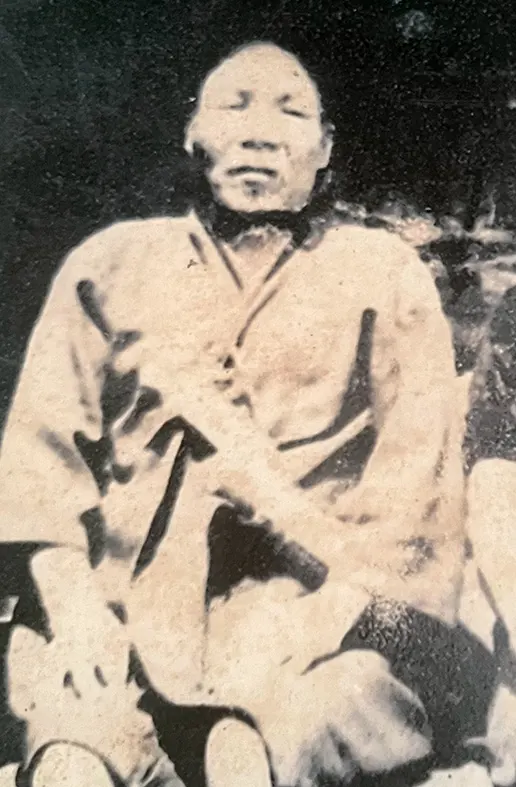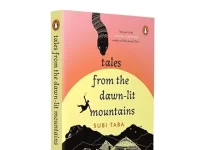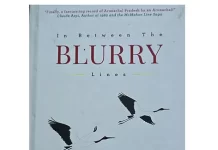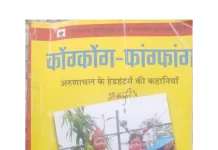TribalBookworms
[Dr Bompi Riba]
This song I sing
of a man called Menlar,
a convict for you
but a warrior for me,
imprisoned for defending
his home with blood
that rendered him
feeling trapped
and asphyxiated.
Never again
the darkness
behind the bars,
that smothering silence
larger than space
more sinister than
a sadistic fiend
threatening to swallow
all of him.
That obliged him
to exile into the wilds
to breathe in
the invigorating scent
of freedom
that controlled
his entire being
that his limbs
he lifted to run
as the voice cried,
‘Run, run, run for your life!
Let the branches bruise your body
Let the thorns tear your skin
Till the darkness is heartening.’
These covered tracks
of his forebear
bore witness
to the lives untold
where the powerfulDikta2 bore
stocky timber
of weight unknown.
Into the torrent plunged
he his two sons
to fight to live
resilient lives,
‘Swim, swim,
swim for your life!’
Echoes that echo
even today.
No ruffian or
a vagabond was Menlar,
a warrior who
slayed for his home
only to be embraced
by the jungle
for the love of freedom
in self-exile.
His pale silhouette
with patches light and dark,
on a sun-kissed hill
against the slithering Ngopihibu3;
a distant longing
for curling smoke
at the plains,
just a nakum4 to return,
a nomad he became!
No rustling of gale5
around the hearth,
no squealing faces
eager for embrace,
no clucking fowls,
no grunting swines,
just an occasional
hobv’s6moo,
his intangible memorabilia!
When the earth rumbled
and wreaked homes,
when Yabi7 swallowed
lives and livestock,
nestled was he
in wedded bliss at Pitak8
which he left behind
for a new home.
Thick with green
the virgin land received
the pioneer’s prayers
to providence
and home he built
along the river teeming
with ngopi9 – its eponym.
He a gaam10 in red
of twenty-three homes,
his marked ownership
in lush green and yellow
at parleys for truce
with hostile golden silk
for the brown earth
conjured men to clash.
His stolen bull
on a non-tribal land,
a bait to kill him
with daos11and arrows
till he struck the schemer
with his shimmering roksa12!
and drenched his tongue
with his blood.
Many moons
since he became earth,
the territorial spirit of the forest
guarding with vengeance
the home he made
till he vanished
in obscurity.
A descendant of Tani13,
now an apparition,
sees his hapless home
entangled in conflict
losing land and lives
here and there,
Was it worth
the sacrifice he made?
The spectre of
the unsung warrior,
whose song
the whoosing wind carried:
“Tani, Nichi, Chide,
Demen, Menra, Raba, Bamv,
Mvkar, Karme, Mechi, Chibo,
Boru, Ruti, Tipo,
Pocho, Chopak, Pakyi, Yima, Madik,
Dikta, Tamen, Menlar”
Menlar, a name in oblivion now!
I begin today’s article with an unpublished ballad of mine written in the year 2022 as a tribute to my husband’s great grandfather, Menlar Ruti. It narrates his ordeal as the pioneer of Ngopi village in Lower Siang district. It is at the foothills and shares a porous boundary with Assam. Through this ballad the perspective of the villagers who looked up to him is narrated. Most youths in the Galo community might not be aware of his feats but many from my parents’ generation are still familiar with this name. He was posthumously awarded a certificate of recognition for his bravery on 10 January, 2024 by the Galo Welfare Society (GWS) on the occasion of its silver jubilee celebration. He had gallantly defended his homeland from the onslaught of the neighbouring community from across the fluid boundary. As a result of which he was convicted and put behind the bars for beheading a non-APST man and wounding his accomplices over conflict over the community land. When he was out on parole, he completely abandoned his village and societal life to live as a recluse in the jungle till his final breath.
This narrative of Ato Menlar was passed onto me by my in-laws and the village elders and I chose to represent it in the form of a ballad because it gave me scope to be powerfully dramatic in my narration while simultaneously integrating lyrical emotions and retaining aesthetics while recounting factual event, despite the ambiguity that arises with the question, ‘what exactly is a ballad’? The most prevalent response to this question is that it is a folksong that tells a story and is transmitted orally rather than by print. Such transmission can be generated among literate as well as non-literate societies. However, there will be a marked difference in the ways of transmission between these two societies. While the former characteristically will not be affected by literate influences, the contrast can be said about the latter. In fact, oral transmission can and have been flourishing among the non-lettered members of the society even without the influence of formal education. However, the emphasis in this article is to develop literature that corresponds to oral tradition as we can actually disseminate our rich folk traditions through creative writings too.
It is understandable that the authenticity of such an approach for documenting historical events or historical figures might be questioned because of the apprehensive possibility of distorting facts, the consequence of which may be the prospects of multiple interpretations. So, basically, they may be considered as unreliable sources of information. But in our defence, can we say that even historians, to some extent make extrapolations on the basis of the information gathered from historical sources and they can never exactly know more than what their documents have preserved for them. For illustration, if there is a photograph of a woman walking on the road with her children, you cannot see the landscape beyond what is offered in the photograph but you can imagine and assume the rest, based on what you are seeing. Therefore, historical sources do have their limitations and each way of seeing may have their particular perspectives. This proves that each source of information, whether it is history or creative writing, has its own advantages and disadvantages.
In the context of societies like that of ours, where there were no written scripts, the community per se depended solely on its oral traditions for validating the history of its migration, tradition and cultural practices but the credibility of oral traditions as historical sources has often been questioned. According to the German historian, Ernst Bernheim, there are five categories of oral traditions viz., “narratives, legends, anecdotes, proverbs, and historical lays” (as quoted in Vansina, Jan. Oral Tradition: A Study in Historical Methodology. Trans. HM Wright, 2017). He further distinguished them under the categories, “first-hand, eye witness report” and “second-hand hearsays” (3) respectively. According to him, the second-hand hearsays must be treated more like legends, the authenticity of which are questionable. Alfred Feder SJ further added to Bernheim’s distinction between first-hand and second-hand reports by categorically expressing his reservations towards those oral tradition with anonymous authorship. Under this category he included the folk tradition such as myths, legends, ballads, tales, proverbs, sagas, rumours, jokes etc. According to him, since the authorship of these folk traditions are unknown, they disqualify as reliable sources as they were transmitted by generations of illiterate people who depended mainly on their memory-power. However, it is to be noted that the observations made by these historians about oral tradition were based on their study of the European society which had the tradition of writing as evident in the survival of manuscripts that consisted poems like ‘Beowulf’ which was written between 975 and 1025 AD. Thus, one can observe the biasness against the oral tradition which encompasses not just story-telling but also unwritten-historical sources that are transmitted from one generation to the other verbally in the forms of either songs or reported statements. These narratives are not restricted to simply recounting the history of a community or a clan or a group; they also encompass the individual kismets of the ancestors, the politics of domesticity in terms of relationships between men and women, taboos, traditions and cultures, etc.
In conclusion, I can only say that there will always be perspectives but that should not be the reason for creative writers to not challenge themselves and I hope that I have justified the sentiments of the descendants of AtoMenlar whose story was narrated through creative writing, which also serves as an alternate history in snippets of the community that he belonged to. (Dr Bompi Riba is Assistant Professor, English Department, Rajiv Gandhi University. She is also a member of the APLS and Din Din Club.)
—————————–
14A form of address for grandfather, great-grandfather, father in-law; here it is used as an address for great- grandfather
15My husband’s great grandfather.
16Ngopi river
17A small stilted house used for resting in fields
18A traditional wrap-around garment worn by a Galo woman
19Mithunor Bos frontalis
20Name of a river
21Name of a place
22A species of fish, commonly known as fresh water grass carp
23Gaon buraor headman
24Machetes used for regular works in and around the domestic space, public space, jungle and fields.
25A size bigger than regular machete. Traditionally, it was used for special occasions such as by warriors during war. It also has cultural significance as it is carried by shamans while performing shamanistic rituals. The shaman moves it subtly to create a rhythmic sound during the ritualistic performance.
26The progenitor of the Tani tribes
(Endnotes)
1A form of address for grandfather, great-grandfather, father in-law; here it is used as an address for great- grandfather
2My husband
’s great grandfather.
3Ngopi river
4A small stilted house used for resting in fields
5A traditional wrap-around garment worn by a Galo woman
6Mithun
or Bos frontalis
7Name of a river
8Name of a place
9A species of fish, commonly known as fresh water grass carp
10Gaon bura
or headman
11Machetes used for regular works in and around the domestic space, public space, jungle and fields.
12A size bigger than regular machete. Traditionally, it was used for special occasions such as by warriors during war. It also has cultural significance as it is carried by shamans while performing shamanistic rituals. The shaman moves it subtly to create a rhythmic sound during the ritualistic performance.
13The progenitor of the Tani tribes.





